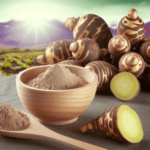Introduction to Maca
Maca, scientifically known as Lepidium meyenii, is a plant native to the Peruvian Andes, revered for its remarkable adaptability to the harsh conditions of high altitudes. For over two millennia, maca has been a staple in the diet of Andean communities, valued not only for its nutritional properties but also for its purported medicinal benefits. The historical significance of maca is deeply rooted in the traditions of indigenous populations, who have utilized the plant’s hypocotyls—the fleshy underground part—for both sustenance and therapeutic purposes. The Spanish chroniclers of the conquest era documented maca’s use, particularly highlighting its role in enhancing fertility and stamina among the native population. This historical narrative underscores the cultural relevance of maca, which continues to be a symbol of endurance and vitality in Andean culture.
Common Uses and Claims
Maca is commonly consumed as a food supplement and is acclaimed for a variety of health claims. Traditionally, it has been associated with increasing energy, stamina, and libido. In modern times, these claims have extended to include improving reproductive health, alleviating menopausal symptoms, and even boosting cognitive function. The versatility of maca, available in powder, capsule, and liquid extract forms, has led to its incorporation into a myriad of dietary products and health regimens. Despite its widespread use, the scientific community remains divided on the efficacy of maca, with some studies supporting its benefits and others calling for more rigorous research.
Overview of the Debate on Efficacy
The debate over maca’s efficacy is ongoing, with a divide between anecdotal evidence and scientific scrutiny. Proponents of maca point to historical use and personal testimonies as validation of its health benefits. However, the scientific community demands empirical evidence obtained through controlled clinical trials. While some studies have shown promising results regarding maca’s impact on libido and reproductive health, others have highlighted the limitations and gaps in research, such as small sample sizes and lack of long-term studies. This has led to a cautious approach by medical professionals, who often emphasize the need for further investigation before making definitive claims about maca’s efficacy.
Scientific Scrutiny of Maca’s Benefits
Analysis of Current Research
The scientific community has shown a growing interest in the potential health benefits of Maca (Lepidium meyenii), a root traditionally used for its nutritional and medicinal properties in the Andean region. Current research has primarily focused on Maca’s impact on sexual function, reproductive health, and hormonal balance. While some studies suggest positive outcomes, the body of evidence remains mixed, with methodological limitations and small sample sizes often cited as concerns. The need for larger, well-designed clinical trials is evident to draw more definitive conclusions about Maca’s efficacy.
Maca’s Impact on Libido and Sexual Function
One of the most publicized benefits of Maca is its purported ability to enhance libido and improve sexual function. Several studies have reported improvements in sexual desire and reduced sexual dysfunction, particularly in menopausal women and men with erectile difficulties. However, the mechanisms behind these effects are not fully understood, and results across studies are inconsistent. Some researchers attribute the benefits to Maca’s adaptogenic properties, which may help modulate stress and contribute to overall well-being.
Potential Benefits for Reproductive Health
Research into Maca’s effects on reproductive health has yielded intriguing findings. Maca has been associated with increased sperm production and motility in men, as well as a potential balancing effect on hormone levels in women. These findings align with traditional uses of Maca for fertility enhancement. Nonetheless, the evidence is not robust enough to recommend Maca as a primary treatment for reproductive health issues.
Maca and Menopausal Symptom Relief
Menopausal women have turned to Maca in hopes of finding relief from symptoms such as hot flashes, mood swings, and sleep disturbances. Some studies report that Maca may exert a beneficial effect on these symptoms, possibly due to its influence on hormonal regulation. However, the data is not conclusive, and further research is needed to validate these claims and establish appropriate dosing guidelines.
Limitations and Gaps in Research
The scientific investigation into Maca’s health benefits is not without its limitations. Many studies suffer from small sample sizes, short durations, and lack of control groups. Additionally, variations in Maca’s phytochemical composition due to different growing conditions and processing methods may lead to inconsistent results. There is also a scarcity of long-term safety data. These gaps in research highlight the need for more rigorous scientific scrutiny before Maca can be widely recommended as a therapeutic agent.

THEN IT CONTAINS TOXIC CHEMICALS. WHY RISK IT GETTING SICK? GO CHEMICAL FREE.
Nutritional Profile of Maca
Maca as a Source of Essential Nutrients
Maca, a root vegetable native to the high Andes of Peru and Bolivia, has been a staple in the diets of the indigenous people for thousands of years. Known scientifically as Lepidium meyenii, maca is often referred to as “Peruvian ginseng” due to its traditional use as a tonic and adaptogen. The nutritional profile of maca is impressive, boasting a rich array of essential nutrients. A single 10 gram serving of maca root contains:
- Carbohydrates: 61%, providing a source of energy
- Protein: 1.6 g, including nearly all essential amino acids
- Fiber: 9.8%, aiding in digestive health
- Fatty Acids: 3.2%, with a balance of saturated and unsaturated acids
- Minerals: High levels of calcium, magnesium, potassium, and iron
- Vitamins: Vitamin C, niacin (B3), and B-vitamins such as thiamin (B1) and riboflavin (B2)
These nutrients contribute to maca’s potential benefits, which include supporting cellular function, bone health, and energy levels.
Comparison with Other Staple Foods
When compared to other staple foods, maca’s nutritional density stands out. It contains more calcium than milk, making it a valuable plant-based source of this bone-strengthening mineral. The protein content in maca is also notable, as it provides bio-available plant protein that is easily assimilated by the body. In terms of vitamins and minerals, maca’s composition includes a higher concentration of certain nutrients like calcium and iron compared to many common vegetables, positioning it as a superfood among its peers.
Dietary Integration in Andean Culture
In traditional Andean culture, maca has been integrated into the diet in various forms. It is consumed either dried or fresh, and often boiled to make a soft product that can be used in juices, soups, and other daily dishes. The boiling process is believed to enhance the bioavailability of maca’s nutrients, making it a powerful component of the Andean diet. The consumption of maca is not only a testament to its adaptability to the harsh Andean climate but also to its revered status as a food capable of providing sustenance and improving stamina and health in the challenging conditions of high altitude.
The nutritional profile of maca, along with its historical significance, makes it a remarkable food that continues to be studied for its health benefits. As a source of essential nutrients, maca provides a synergistic blend that supports overall well-being, making it a valuable addition to modern diets.
By the way, something for you, a little gift!!!
I am just in the middle of publishing my book. It’s about How women can balance their hormones. One part is about food and diet, of course.
Follow this link and enter your email.
I will send you this part of the book for free once the book is published. It has many concrete, practical tips and recipes and will help you feel better during menopause or times of Big hormonal fluctuations.
Annette, Damiva Lead for Health & Wellness

Maca in Traditional and Modern Diets
Traditional Preparation and Consumption
The traditional use of maca, a root vegetable native to the Peruvian Andes, dates back over two millennia. Indigenous communities revered maca for its ability to thrive in harsh climates and its perceived health benefits. Traditionally, after harvest, maca is sun-dried and can be stored for years. The dried hypocotyls are incredibly hard and must be boiled in water to soften them before consumption. This process is believed to enhance maca’s bioactive properties, particularly its glucosinolate content, which is sensitive to heat. The most common traditional consumption method is in the form of a juice made from the boiled maca. This preparation method is still practiced in Andean culture, reflecting a deep respect for ancestral dietary customs.
Modern Uses and Adaptations
In modern diets, maca has been adapted into various forms to cater to contemporary lifestyles. The root is now available as a powder, which can be easily incorporated into smoothies, baked goods, and other recipes. Capsules and extracts are also common, offering a convenient way to consume maca without the need for preparation. Modern research has sparked interest in maca’s potential for improving sexual function, fertility, and energy levels, leading to its integration into daily supplements by people around the world.
Global Popularity and Dietary Trends
Maca’s rise to global fame can be attributed to its promotion as a “superfood” with adaptogenic qualities. The export of maca from Peru has seen a significant increase, reflecting its growing popularity. As a dietary supplement, maca is sought after for its purported benefits, which include boosting libido, enhancing athletic performance, and providing essential nutrients. Its adoption by health enthusiasts and the wellness industry has cemented maca’s status as a staple in the global health food market.
Safety and Side Effects
Evaluating the Safety of Maca Consumption
The safety profile of Maca (Lepidium meyenii) is generally considered to be favorable. Maca has been consumed as a food and medicinal plant in the Andes for thousands of years, with few reported adverse effects. The root is typically dried and consumed in powder form, added to meals, or taken as a supplement. While Maca is not regulated by the FDA as a drug, it is important to choose supplements that have been tested by trusted third parties such as USP, ConsumerLabs, or NSF to ensure quality and safety.
Reported Side Effects and Concerns
Although Maca is consumed widely and is considered safe for most people, some individuals may experience side effects. These can include mild gastrointestinal symptoms such as bloating and indigestion, as well as headaches. There have been subjective reports of altered menstrual cycles, mood changes, cramps, gastritis, and insomnia. The effects of Maca on hormone levels are not fully understood, with some studies reporting no significant impact on sex hormones, while others, particularly animal studies, have noted increases in certain hormones like luteinizing hormone, progesterone, and testosterone.
Because Maca may act similarly to estrogen, individuals with hormone-sensitive conditions such as breast, uterine, or ovarian cancer, endometriosis, or uterine fibroids should consult with a healthcare provider before using Maca. Additionally, a case study from 2018 highlighted a woman whose blood lead concentration increased after consuming a Maca supplement, suggesting the need for caution and thorough research into the source of Maca products.
Guidelines for Safe Supplement Use
To minimize the risk of side effects and ensure safe use of Maca supplements, the following guidelines are recommended:
- Consult a Healthcare Provider: Before starting any new supplement, including Maca, it is crucial to discuss it with a healthcare provider, especially if you are pregnant, nursing, have any medical conditions, or are taking any medications.
- Appropriate Dosage: There is no standard recommended dose for Maca, but studies have used dosages ranging from 1.5 to 3 grams per day. It is important not to exceed the manufacturer’s recommended dosage and to consult with a healthcare provider for personalized dosing.
- Quality Products: Choose Maca products that have been third-party tested for quality and purity. This helps to ensure that the product is free from contaminants and contains the ingredients listed on the label.
- Monitoring and Evaluation: Monitor your body’s response to Maca and report any adverse effects to your healthcare provider. If side effects occur, discontinue use and seek medical advice.
- Special Populations: Children, pregnant or lactating individuals, and those with hormone-sensitive conditions should avoid Maca unless advised otherwise by a healthcare professional.
In summary, while Maca is generally considered safe and has been a staple in Andean culture for centuries, it is important to use it responsibly and with the guidance of a healthcare provider to ensure its safe integration into your health regimen.

From unhappy, dry, and sandpaper to silky, smooth and feeling good. That’s Cleo. Cleo is a 100% natural labial balm to moisture and soothe “your other lips”. Cleo is chemical-free, water-free, pH optimized and helps maintain and restore your delicate labial skin’s natural flora. Ideal for daily use or as needed. Get the most silky, lovable lips ever.
Expert Opinions and Anecdotal Evidence
Medical Professionals’ Stance on Maca
Medical professionals often approach natural supplements like maca with cautious optimism. While acknowledging the historical use of maca root for various health benefits, many healthcare providers emphasize the need for more extensive clinical research to validate these claims. The adaptogenic properties of maca, which are said to help the body adapt to stress and balance hormones, are recognized, but doctors typically advise patients to consult with them before integrating maca into their health regimen, especially if they are pregnant, breastfeeding, or have hormone-sensitive conditions.
Personal Testimonies and Practice Observations
Anecdotal evidence from individuals who have incorporated maca into their diets often speaks to its positive impact on energy levels, mood, and sexual function. Some users report noticeable improvements in libido and a general sense of well-being after starting maca supplementation. However, these personal testimonies are not a substitute for scientific evidence and should be taken with a grain of salt. Practitioners of alternative medicine may share observations from their practice, noting that some patients experience benefits from maca, but these observations do not equate to controlled, peer-reviewed studies.
Contrasting Scientific Evidence with Folk Beliefs
The scientific scrutiny of maca is ongoing, with some studies suggesting potential benefits for libido enhancement, mood improvement, and reproductive health. However, the body of evidence is not yet robust enough to make definitive health claims. This contrasts with the rich folk beliefs surrounding maca, which hail it as a powerful remedy for a range of ailments and a booster for sexual and cognitive functions. While folk beliefs are rooted in centuries of traditional use, they often lack the rigorous testing and validation found in scientific research. As such, the medical community remains cautious, advocating for more high-quality studies to establish the efficacy and safety of maca conclusively.
Conclusion and Future Directions
Summarizing the Current Understanding of Maca
The body of research on Maca (Lepidium meyenii), a traditional Andean plant, has grown significantly, revealing its multifaceted impact on human health. Studies have highlighted Maca’s potential benefits in enhancing libido, sexual function, and reproductive health. Notably, different phenotypes of Maca, such as red and black Maca, have been shown to possess distinct biological properties. Red Maca, in particular, has demonstrated a more pronounced effect on mood and energy levels, potentially due to its influence on the endocannabinoid system and mood-regulating neurotransmitters. Additionally, Maca’s nutritional profile, rich in essential nutrients like macamides, GABA, and choline, contributes to its health-promoting effects.
Potential for Future Research and Discoveries
Despite the promising findings, there are still gaps in the research that warrant further investigation. Future studies should aim to clarify the mechanisms by which Maca exerts its effects, particularly its role in modulating neurotransmitter pathways and hormonal balance. The potential of Maca to address chronic mountain sickness (CMS) and its impact on hemoglobin levels at high altitudes also presents an intriguing avenue for research. Moreover, the safety and efficacy of Maca in various populations, including postmenopausal women and individuals with metabolic syndrome, require more comprehensive studies to establish clear guidelines for its use.
Final Thoughts on Integrating Maca into Health Regimens
Integrating Maca into health regimens should be approached with consideration of individual health status and needs. While Maca shows promise as a supplement for enhancing mood, energy, and sexual well-being, it is not a one-size-fits-all solution. Medical professionals should evaluate the potential benefits and risks of Maca for each patient, taking into account the existing scientific evidence and anecdotal reports. As research continues to uncover the complexities of Maca’s effects on human health, it is essential to balance scientific findings with traditional knowledge and individual experiences to optimize its use as a health supplement.
Recommended by Health Care Professionals. Loved by thousands of women who got their life back.












